Chapter 2. The California Broadband Market
2.1 Broadband is Widely Deployed in California
The analysis that follows is based largely on data reported by carriers to the FCC's Form 477 survey for June 2004. We acknowledge the limitations on this Report's ability to more accurately assess the availability of broadband in California that are imposed by our reliance on the FCC Form 477 data. The FCC Local Competition and Broadband Form 477 data (collected semiannually in December and June) used to prepare the maps and tables presented here is based on the outmoded FCC definition of broadband, and is derived from responses from only those providers having 250 or more customers. In addition, all data is collected by zip code, and does not include the number of customers in each zip code. Accordingly, an entire zip code may be characterized as having broadband availability, even if only a part of that zip code has such availability.16
The FCC data was augmented by independent CPUC research,17 and has been compiled into a set of maps (see separate files for Maps 1 through 4).
Map 1 illustrates that broadband is available in every California zip code. All four broadband technologies surveyed in the FCC 477 report (Wireless, DSL, Cable and Satellite) are available in 26% of California zip codes, and 39% of California zip codes have DSL, Cable and Satellite broadband technologies available.
Figure 2.1
Broadband Availability in California Zip Codes18
|
Services |
Percentage of Zip Codes |
DSL, Cable Modem and Satellite |
39 |
DSL, Cable Modem, Wireless and Satellite |
26 |
DSL and Satellite |
19 |
Cable Modem and Satellite |
3 |
Satellite only |
13 |
Total |
100 |
Data on cable modem availability indicates that broadband service is much more widely available than is shown by the FCC data, however. According to the National Cable & Telecommunications Association, 12,440,053 California homes are passed by cable, a figure that represents approximately 97% of all homes with television service in the state. 11,960,046 of these homes, or approximately 96%, have broadband cable modem service available; 264,574 or approximately 2% do not have cable modem service; and data was not available for the remaining 215,433 homes, or 2%. However, a high percentage of these 2,753,687 homes are believed to have cable modem service.19 Of all homes passed by cable, it is estimated that at least 90% have broadband service available to them via cable modem.20
Map 2 illustrates the wide choice of broadband service providers in California. Areas of the map that are shaded red, which are primarily located in major metropolitan areas, have access to at least 11 or more broadband service providers. As shown in Figure 2.2 below, two or more broadband providers serve almost every California zip code (93%). A majority of California zip codes are served by four or more broadband providers.
Figure 2.2
Broadband Service Providers in California Zip Codes
|
Number of Providers |
Percentage of Zip Codes |
1 |
7 |
2-3 |
35 |
4-5 |
10 |
6-10 |
17 |
11 + |
31 |
Total |
100 |
Map 3 illustrates population density in California, with the red areas being those with the most population (100,001 to 3,912,200 people) and green representing those with less than 5,000 people. Viewing this map in conjunction with the two other maps illustrates that multiple broadband providers service the major population areas in California, and that consumers within those zip code areas have multiple broadband providers available to them.
The last map, Map 4, depicts the most current information on WiFi hotspots in California. "WiFi" is the abbreviated term for wireless fidelity, and "WiFi hotspots" are physical locations such as cafes, hotels, and airports where wireless connections to the Internet are offered. Most public WiFi hotspots require paid subscriptions -- hourly, daily or monthly -- for access, although there are a growing number of free hotspots.
There are now more than 50,000 WiFi hotspots around the globe. The number of hotspots around the globe is believed to have increased more than 40% since July 2004 alone - from 35,000 locations just seven months ago21 - and new hotspots are being developed at a furious pace. The United States leads the world in hotspot availability, having more than 21,000 cities where WiFi hotspots can be found. California leads the country with 3,848 -- more than double New York's 1,546 hotspots. San Francisco ranked ninth among the top ten cities, with 382 hotspots. Other California areas with significant WiFi hotspots are Oakland, Los Angeles, San Jose, Orange County, and San Diego.
The number of hotspots in California and elsewhere will continue to increase at a rapid pace, as the number of consumers able to access them with their laptops grows. More than 30 million laptop computers with wireless broadband capability were sold in 2003, and experts predict that in less than two years, 100% of all laptop computers sold will be WiFi capable.22
2.2 Broadband Access in California Leads the Nation
California leads the nation in the total number of broadband lines23 as well as overall national broadband market share. Figure 2.3 below shows the number of broadband lines for the ten most populous states in the nation. As of June 2004, California had 4.69 million broadband lines, almost as many as New York and Florida combined. 24
Figure 2.3
California Leads the Nation in Broadband Lines (in millions)
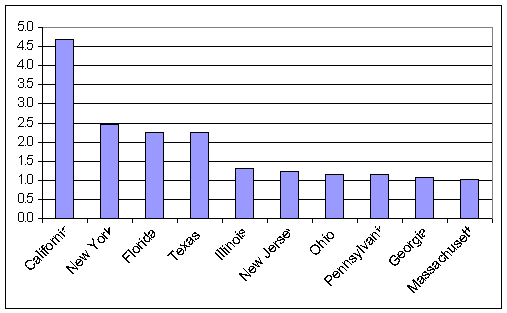
2.3 Rapid Growth In California Broadband Market
From June of 2000 to June of 2004, California's broadband market expanded by 516%, growing from 900,000 to just over 4.69 million broadband lines (See Figure 2.4 below).
Figure 2.4
Growth in Broadband Lines in California (in millions)
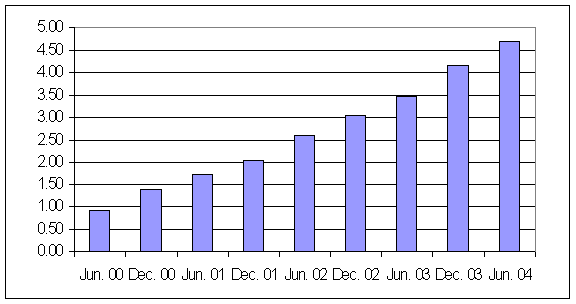
During the same 48-month period, the national broadband market grew by 751%, increasing from 4.3 million broadband lines in June 2000 to 32.4 million broadband lines in June 2004.
Figure 2.5
Growth in Broadband Lines Nationwide (in millions)
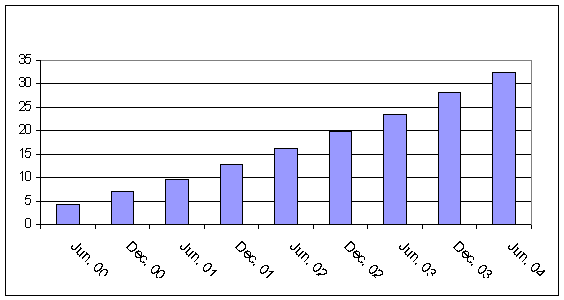
2.4 California Broadband Penetration Lead Continues to Grow
While the rate of growth of the U.S. broadband market exceeded that of the California market (751% vs. 516%), it is important to remember that California was well ahead of the rest of nation in its broadband penetration rate (3.1 vs. 1.46 broadband lines per 100 persons) in June 2000. California's early market maturation has resulted in a slightly lower rate of growth compared to other states. However, California's lead in broadband penetration compared to other states has continued to grow. In December 2000, California had 1.64 more broadband lines per 100 persons than the average of other states. By June 2004, California's lead had grown to 3.57 more broadband lines per 100 persons than the average of other states.
Figure 2.6
Broadband Lines Per 100 Persons
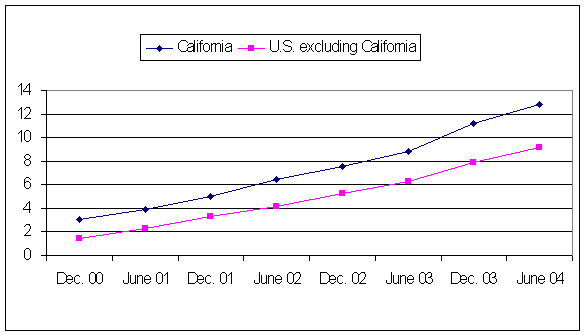
2.5 California's Share of National Broadband Market
California leads all other states in its share of the national broadband market as a percentage of population. The following figure illustrates that California's broadband market is 19% larger than its population would otherwise indicate, with 14% of the national broadband market and 12% of the nation's population. New York's broadband market share is 13% higher than its population share, while Florida's is 19% higher. On the other hand, the Texas and Illinois broadband markets are 5% and 10% smaller, respectively, than their shares of the U.S. population.
Figure 2.7
Share of Population vs. Share of Broadband Market
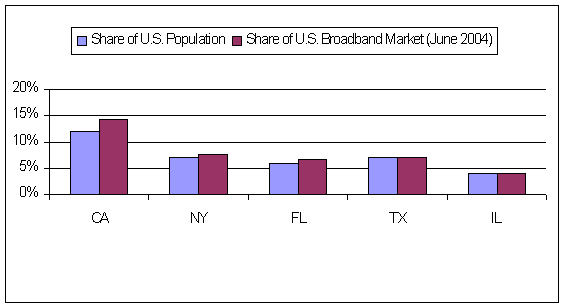
2.6 Is Broadband Reaching Everyone?
Despite California's success and national leadership on broadband penetration, not all of the state's residents have access to, or are using, broadband. Certain communities are lagging behind: low-income consumers, residents of rural areas, and persons with disabilities.
Disparity in the access to, and use of, broadband among certain communities is now commonly referred to as the "digital divide," much as that term was used in the past to describe the gap between those who owned computers and those who did not, and later to describe the gap between those who used the Internet and those who did not. Much of the information available on the digital divide still examines that issue in terms of access to the Internet or access to a personal computer. Although these studies and statistics do not directly address broadband deployment and use, we include examples of them here because we believe them to be of probative value in addressing the problem of unequal access to, and use of, broadband.
Much of the data found addresses the "digital divide" in the United States, not in California specifically, regardless of one's definition of that term.
As recently as September 2004, the United States Department of Commerce released data on the disparate rates of Internet usage among certain communities, shown in Figure 2.8 below.
Figure 2.8
Internet Usage: Percent of U.S. Population Online
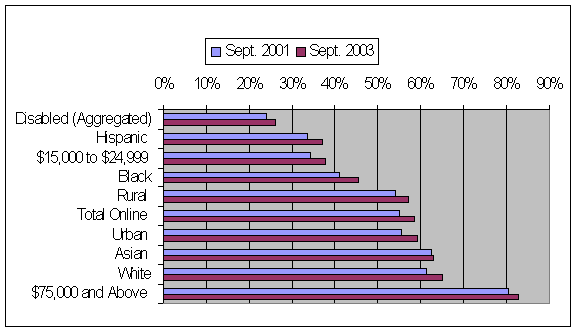 U.S. Department of Commerce, "A Nation Online: Entering the Broadband Age," September 2004.
U.S. Department of Commerce, "A Nation Online: Entering the Broadband Age," September 2004.
The data shows disabled populations being the least connected to the Internet (24% in 2001 and 26% in 2003), with the most connected being households with a family income of $75,000 and over (80% in 2001 and 83% in 2003). Other lower use groups include Hispanics of any race (33% in 2001 and 37% in 2003), low income persons (34% in 2001 and 38% in 2003), and Blacks (41% in 2001 and 46% in 2003).25 The statistics revealed almost no difference among the total United States population online and the rural and urban populations online - all three were approximately 57% in 2003.26
2.6.1. Disabled Community
Access to broadband, and the wealth of information and resources it provides, presents a critical opportunity for people living with disabilities to live fuller, more "connected" lives. Yet, a study entitled "Disability Watch: The Status of People with Disabilities in the United States," found in 2001 that 24% of disabled individuals had access to a personal computer (compared with 52% for non-disabled), and only 10% of disabled individuals had access to the Internet, either through a dial-up or broadband connection (compared with 38% for non-disabled).27 This data appears to conflict with the U.S. Department of Commerce data showing disabled community Internet usage at over twice that level.
Figure 2.9
Computer Access and Internet Use
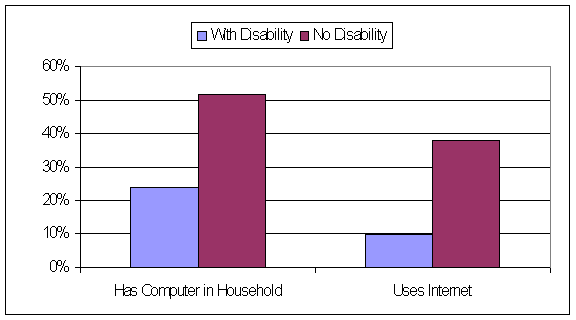
As the following chart illustrates, cost appears to be the primary barrier to bridging the technology gap between the disabled and non-disabled communities. With lower average incomes, 11% of low-income people with disabilities use computers, compared to 22% of other low-income persons .28 Computer use increases at higher income levels for persons with and without disabilities.29
Figure 2.10
Computer Use by Household Income
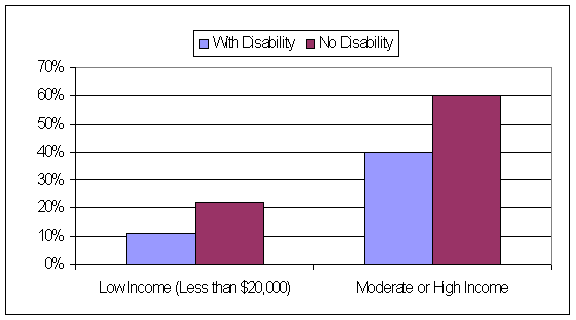
The rate of Internet use among low-income people with disabilities is only 5%, while the rate for those with higher incomes is more than three times higher, at 17%. Persons with no disability use the Internet at 19% and 45%, respectively, for low income and moderate or high income households.30
Figure 2.11
Internet Use by Household Income
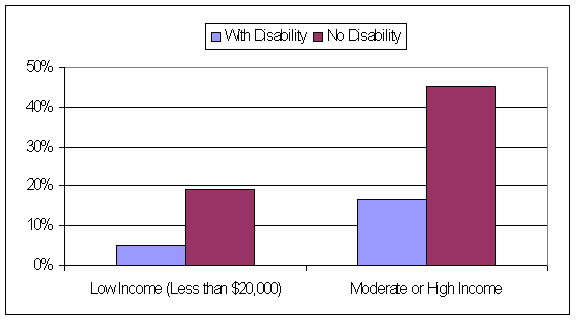
2.6.2 Rural Areas
Although the U.S. Commerce Department data cited in Figure 2.8 above fails to illustrate a significant difference in Internet use between rural and urban residents, other studies such as the Pew Internet & American Life Project's "Rural Areas and the Internet"31 do cite a significant difference, as shown in Figure 2.12 below.
Figure 2.12
Internet Penetration by Community Type32
2000 |
2003 | |
Rural |
41% |
52% |
Urban |
51% |
67% |
While Internet access has grown in rural areas between 2000 and 2003, urban access has grown as well, with the disparity between the two increasing from 10% to 15% in those three years.
2.6.3 Lower Income Individuals
Despite the trend toward lower prices, computers and Internet access remain more expensive than many low-income individuals can afford. The following table shows Internet access by urban households with incomes of less than $30,000 to range between 38% and 54%, while urban households with incomes above $30,000 range from 70% to 93% Internet access. Internet access is lower for rural populations than urban populations at almost all income levels, with the difference being generally greater at lower income levels and fairly low at higher income levels.33
Figure 2.13
Percentage Urban/Rural Internet Penetration by Household Income34
|
Under $10K |
$10K -$20K |
$20K -$30K |
$30K -$40K |
$40K -$50K |
$50K -$75K |
$75K -$100K |
$100K and Greater | |
|
Urban |
38% |
52% |
54% |
70% |
79% |
83% |
93% |
90% |
|
Rural |
19% |
35% |
39% |
66% |
73% |
76% |
85% |
89% |
Difference: Urban vs. Rural |
19% |
17% |
16% |
4% |
6% |
7% |
8% |
1% |
2.6.4 A California-specific Study
The Center for Justice, Tolerance and Community at the University of California Santa Cruz has worked to quantify and analyze the "digital divide" in California, and recently published its work in a report entitled "A Nation Offline? Research on the Digital Divide."35
The report found that an increasing number of California households have computers, are accessing the internet, and are using broadband to access the internet. By 2003, over 66% of California households had computers, almost all households with computers had access to the internet, and close to half of all households with computers had access to broadband.36
Figure 2.14
The report found a strong correlation between household income and broadband. In 2003, California households with annual income of over $75,000 were more than six times as likely to have broadband connectivity than households with annual income of less than $15,000.37
Figure 2.15
The report also examined broadband penetration rates based on ethnicity, and found that Anglo and Asian households in California were more than twice as likely to have broadband than African-American and Latino households (as shown in Figure 2.16 below).38
Figure 2.16
The report then examined the existence of broadband in California households in 2003 by both annual income and ethnicity. It found that households with annual incomes of over $50,000 were the most likely to have broadband connectivity, and households with annual incomes of less than $20,000 were the least likely to have broadband, regardless of ethnicity. The report did find, however, that disparities existed within the three household income groups based on ethnicity.39
Figure 2.17
32 Ibid., p. 8.
33 Ibid., p. 34. 34 Ibid. 35 Rob Fairlie, Rebecca London, Manuel Pastor, Rachel Rosner, "A Nation Offline? Research on the Digital Divide," Center for Justice, Tolerance & Community, University of California Santa Cruz, 2003; www.cjtc.ucsc.edu;digitaldivide.html. 36 Ibid. 37 Ibid. 38 Ibid. 39 Ibid.


